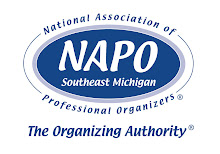How prepared are you for an emergency?
The National Association of Professional Organizers Chapter in Michigan has provided a summary of the American Red Cross and FEMA recommendations for emergency preparedness.
1. Get Informed. Know your community’s emergency plan including the following:
·
Community response plan
·
Community evacuation plan
·
Emergency shelter locations
·
Community warning/alert systems
·
Other community plans
2. Make a Plan. The best way to
be prepared is to have a plan and communicate it to all family members. The plan should include the following elements:
·
Communication Plan
o
Key Contacts List. Prepare a list of key
contacts that can be used by family members to seek help when needed. The key contacts list should be placed in a
visible location within the home, entered into every family member’s mobile
phones or placed in children’s back packs.
o
Designate out-of-state contacts. Make certain that the key contact list
includes contacts that are located outside the community and, if possible,
outside the state. It may be easier to call
a person outside the area if a disaster strikes locally.
o
Define emergency meeting locations. Identify a location outside the home and
outside the community where the family can gather if they cannot access the
home or the area due to a fire, tornado or other disaster.
·
Define Escape Routes Outline how to evacuate your home, subdivision and neighborhood. If your home is two levels, a route to escape
the upper level should be defined along with an escape ladder.
·
Define Shelter-In-Place Locations Identify the locations within the home where
you can take cover in a weather or disaster situation.
·
Obtain and Use Equipment
The following equipment should be obtained and checked regularly for
functionality:
fire extinguishers,
smoke detectors,
carbon monoxide detectors and
escape ladders.
Family
members should be trained on how to use fire extinguishers and fire ladders.
3. Assemble a Disaster Supply Kit.
A disaster supply kit should be assembled keeping in mind the needs of family
members and pets. A list of items to
include can be found at: www.ready.gov/basic-disaster-supplies-kit. The supply kit should be placed
in a designated, yet accessible, location for all family members.
4. Maintain Your Plan. Your plan becomes effective only when it is
communicated, practiced and updated.
Make a commitment to review your plan with the family at least annually
by indicating a date on your calendar to perform this. Regularly update any equipment, evacuation
routes, key contacts or any plan aspects.
You will
appreciate that you were prepared when an emergency happens!
For more
organizing tips, visit www.NapoMichigan.com.
Article submitted by Chapter Member Mary Lynn Badr, Professional Organizer, Imagine It DONE, LLC.
Article submitted by Chapter Member Mary Lynn Badr, Professional Organizer, Imagine It DONE, LLC.

